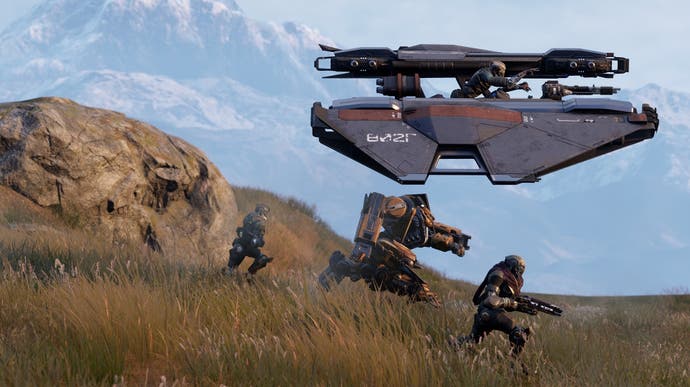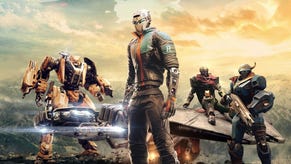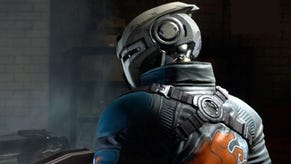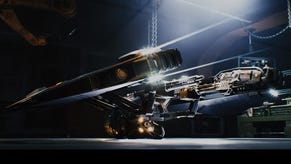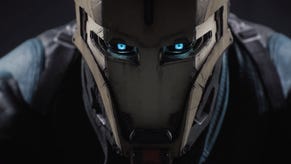In single-player, Disintegration feels like the real Halo 2 to me
Thank you for the memories, V1!
I have a theory, sweetly unburdened by any kind of evidence, that argues that developers sometimes try to recreate the power and pleasures of using actual game-creation tools for their players, but without the attendant need to understand maths or architecture or much in the way of technology. To put it another way, I suspect they take what they love about a tool or a bit of software, and they transform it into something the player can love too.
I feel that very strongly while moving about on Disintegration's Gravcycle, a beautiful machine, all but invisible to the first-person player during main missions, but constantly present in the way it ghosts over the rock and dirt and concrete of the game's levels, directed, it seems, more by impulse and desire than the things I'm doing with the sticks and triggers of the pad. It seems to know where I want to go. Physically, the Gravcycle borrows its iconography from motorbikes - all those beautiful pipes and vents and exhausts. But what it really feels like is the "freecam" movement you get from the debug viewers in a game engine. It feels like a dream.
Disintegration is one of those games that always makes me think of the way games are made, and that's not just because of the debug Gravcycle, or even now, the sad news this week that V1 is closing down. It's partly to do with the developer's lineage with the Halo series, I suspect, but not entirely. It's also because of the skill and pleasure that I tell myself I can see in the way it's all been put together. Disintegration's is a sparse kind of design, which might have something to do with budget, certainly, but which feels like it has more to do with experience. Take the Gravcycle again - give players a machine like that, with so much care in the handling, and people are going to have fun. Disintegration's makers seem to understand what you need as a player and what you don't need. No wonder I returned to Disintegration this past week, and fell in love all over again.
I want to say Disintegration is a story of transhumanism in the nearish future? Humanity has largely given up flesh for robotic metal frames, and now stuff is kicking off because of it. There is more nuance there, but the narrative is really in place to power a range of single-player missions in which you and a band of robot buddies stick it to the mechanical man. It's also there to create surprisingly watchable cut-scenes and decent chatter as the missions progress. Disintegration, it quickly becomes apparent, has charm - charm is always measured in the oodle, incidentally, just as induction is measured in henrys - and a sense of humour. I don't know what humour is measured in.
All of this was visible right at the start of the single-player campaign, as it happens, with an early cinematic trailer that laid out the game's backstory and focused in on its hardware but also, crucially, had time for a bit of character and a jokey climax. It's weird to think that some of the people behind Halo managed to go on and make a far more human narrative in part by basing it around a bunch of robots. (I won't be able to talk about multiplayer here because I never played it - apologies!)
Halo! I always go through the same journey when playing Disintegration. I think about Halo a lot, and feel bad about it, because Disintegration is more than good enough to not be seen though the lens of another game, and then suddenly I realise that it's through the lens of Halo that Disintegration truly becomes its own game. The things it does brilliantly become most apparent when you're coming from thinking about the Chief.
At first, the similarities are almost overwhelming. Disintegration wisely stages Halo's often forgotten (to me at least) ship-escape opening mission as a cut-scene, so that the real adventure can properly kick off where I always incorrectly remember Halo's beginning - alone in the great outdoors. Once again, it's the Pacific Northwest, with its firs and mountains, and Halo is everywhere in these first few moments. There are familiar snatches of Tupperware blue on the HUD, the familiar sharp metallic rattle of AR bullets. After a while I realise that the low vacuum purr of the Gravcycle I move around on even reminds me of the ominous hum of Covenant dropships turning swiftly overhead.
It's weird, though, because Disintegration is anything but a clone or a repeat pass. Halo was a shooter, but Disintegration is a shooter and RTS hybrid - you can blast away at enemies, but it's also crucial to use your Gravcycle mobility to move around like a general, directing the fire of your troops. No choral voices, no shoot-and-then-whack finishers. Disintegration is missing so much of the classic Halo thirty-seconds, two-slot DNA, and yet initially it still feels like Halo in its bones. It makes me wonder if we've been locating the heart of the series in the right place all along. Maybe it's more about the wide path that always stretches forward, the environment surrounding you with hints of the Dark Divide.
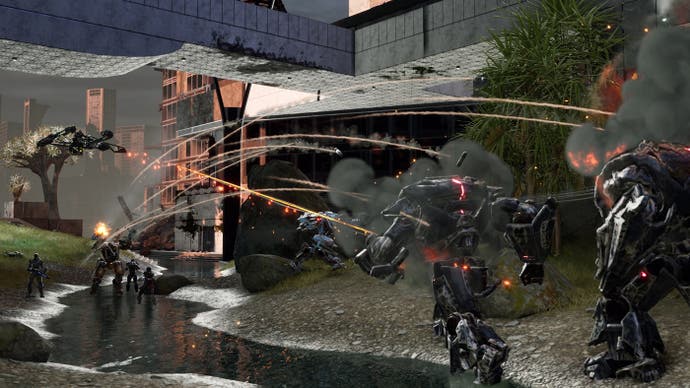
Sort of. What it truly shares with Halo, I think, is faith. Faith that simple weapons reward mastery. Faith that a well-staged encounter that forces you to use the landscape around you is a more reliable generator of fun than an elaborately scripted set-piece in which the landscape becomes a one-shot prop, a piece of plasterboard loaded with squibs. Faith, more than anything, in roominess, in those trails and rocky basins, protected by a Bob Ross perimeter of happy trees and artfully sculpted peaks. In empty cities that really do stretch off in a couple of directions - in cities that still feel like wilderness with a bit of range to them.
And this is the point at which Disintegration moves beyond Halo: faith that you can take a good idea and properly twist it a bit. That RTS element, though initially lightly handled, does so much to make Disintegration its own thing. It takes the Halo sensibility of being small and deadly in a huge directed wilderness, and it gives you extra things to do. Why bother with grenades when you can control troops who have their own grenades? Why headshot and then thwack each baddy when you can assign your people to do that for you while you do something else of equal importance. It's the thirty seconds of fun, but playing out in several additional dimensions.
This is what Disintegration really makes me think about then: it doesn't evoke Halo so much as it evokes a Halo 2 that never happened - one that was a bit more daring, and that trusted the audience to follow them somewhere new and fun, but which still made sense. Just as Torchlight 2 is a sort of Diablo 3 in a mirror-world - it's another response to Diablo 2, made in part by the people who made that earlier game - Disintegration is a mirror-world Halo follow-up. And a total treat with it. Thank you, V1.
